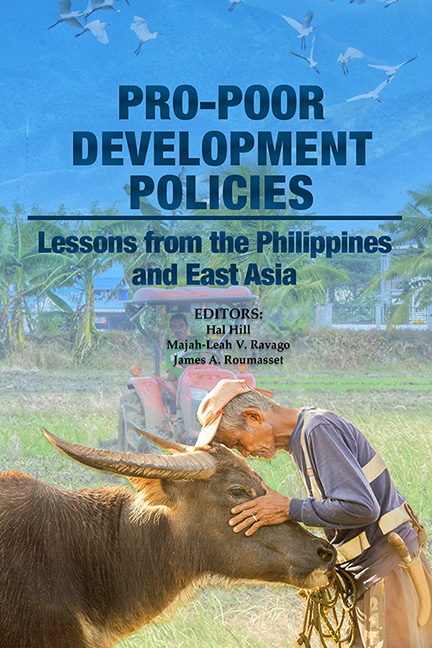Book contents
- Frontmatter
- Dedication
- Contents
- Figures, Tables and Boxes
- Foreword
- Foreword
- Message
- Preface and Acknowledgements
- About the Editors
- About the Contributors
- Acronyms
- Part 1 Introduction and Synthesis
- Part 2 Agricultural and Economic Development
- Part 3 Economic Policies for Achieving Targeted Levels of Living in the Philippines
- Part 4 Inequality and Economic Development
- Part 5 Competition Law and Policy
- Part 6 International Dimensions
- Index
19 - Competition and Employment Growth in the Philippines: A Baseline Assessment
Published online by Cambridge University Press: 09 January 2024
- Frontmatter
- Dedication
- Contents
- Figures, Tables and Boxes
- Foreword
- Foreword
- Message
- Preface and Acknowledgements
- About the Editors
- About the Contributors
- Acronyms
- Part 1 Introduction and Synthesis
- Part 2 Agricultural and Economic Development
- Part 3 Economic Policies for Achieving Targeted Levels of Living in the Philippines
- Part 4 Inequality and Economic Development
- Part 5 Competition Law and Policy
- Part 6 International Dimensions
- Index
Summary
BACKGROUND
In theory, employment growth is one of the dynamic gains expected from increased competition in markets. The basic intuition is that with increased competition, factor productivity increases, prices of goods and services are lower and, consequently, demand for goods, services and labour is higher (Nickell 1999; Layard, Nickell, and Jackman 1991; Hay and Liu 1997; OECD 1997). Firms could also dynamically respond to competition that could increase output and demand for labour, such as introduce new and improved products and processes that will require or result in the hiring of more workers (Aghion et al. 2005; Pianta 2005). In the short run, however, competitive pressures could force firms to undertake cost-cutting measures, including retrenching employees. Hence, an important concern among economic managers is whether competition kills or creates jobs (OECD 2015).
The concern is particularly relevant in countries where antitrust law is relatively new. In the Philippines, the competition law came to force in 2015, after over two decades of congressional deliberations. The Philippine Competition Act (PCA) prohibits anticompetitive agreements, abuse of dominant position, and anticompetitive mergers and acquisitions in all sectors of the economy (Republic Act No. 10667, An Act Providing for a National Competition Policy Prohibiting Anti‑Competitive Agreements, Abuse of Dominant Position and Anti‑Competitive Mergers and Acquisitions, Establishing the Philippine Competition Commission and Appropriating Funds Therefor).
Scholars have characterized the Philippine economy, particularly the manufacturing sector, as highly concentrated (Medalla 2003). Aldaba (2008) points to historical factors causing such concentration, particularly the protectionist policies in the 1950s up to the early 1980s, when removal of tariff and non-tariff barriers was initiated. Further, barriers to trade combined with heavy government regulation, as well as government-tolerated collusive practices, have contributed to the oligopolistic structure of the Philippine manufacturing industry. Protectionism also stems from several highly restrictive economic provisions in the Philippine Constitution. According to Sicat (2005):
“The economic provisions of the Constitution are the barriers that make us into a high-cost economy, thereby burdening the country with loss of competitive capacity. The country has reached a point that requires the relaxation of these limitations on foreign capital so that we can raise the level and quality of national economic performance. Foreign direct investment will provide the quickest way to generate more capital to raise the economy’s overall performance.”
- Type
- Chapter
- Information
- Pro-poor Development PoliciesLessons from the Philippines and East Asia, pp. 546 - 573Publisher: ISEAS–Yusof Ishak InstitutePrint publication year: 2022

